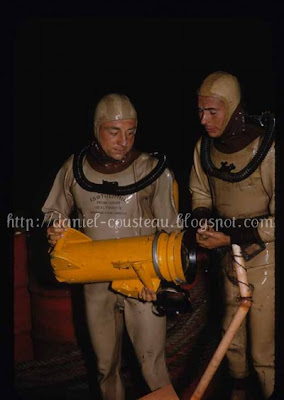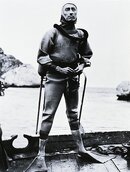You are using an out of date browser. It may not display this or other websites correctly.
You should upgrade or use an alternative browser.
You should upgrade or use an alternative browser.
Cousteau Wetsuit
- Thread starter Tickler
- Start date
Please register or login
Welcome to ScubaBoard, the world's largest scuba diving community. Registration is not required to read the forums, but we encourage you to join. Joining has its benefits and enables you to participate in the discussions.
Benefits of registering include
- Ability to post and comment on topics and discussions.
- A Free photo gallery to share your dive photos with the world.
- You can make this box go away
When I filmed with a Japanese crew for NHK (Japan's public TV network), they wore suits like these. Back in my early days I wore one too. Quite a different experience from today's marginal neoprene. I had the neoprene on one recent wetsuit literally dissolve away in the crotch and armpits. The fabric was still in good shape but when I held the suit up to the light, it shone right through huge holes.
Here is Jean-Michel Cousteau in the silver wetsuits used during the filming of a 1985 documentary on board Alcyone:
View attachment 169903 View attachment 169904
Looks like a casting call for Planet of the Apes
Wetwear makes them out of G-231N..... Darn good suit.
I found that while looking for these suits. I might have to invest in a custom Cousteau suit soon.
I grew up with these types of suits. The wet suit was pretty warm if it was thick enough. In Oregon we wore 1/4 inch thick neoprene. I liked the skin-one-side suits that I needed to use corn starch to get into. Phisohex soap is not good to use, as it has ingredients in it which probably are not good to keep on the skin--hexiclorophene. I used phisohex soap to clean wounds when in the U.S. Air Force, as it is a disinfectant; it was part of our medical kits. But with corn starch, you slide into these suits very easily, and because they were only stitched on one side, they were waterproof at the seals. The best for warmth had no zippers, and were pull-over suits. Some had a short upside-down zipper in the chest, which allowed easier entry and still stayed warm.
The yellow stripes you see are actually seam tape, used to ensure that the seams did not part (before nylon lining and sewn seams). They also look pretty nice in the water too. Cousteau made a study and determined the yellow was the most visible color to use for his divers. They did use silver too, but I like the yellow strips better than the silver. I once had a silver suit, but it was so stiff I had to return it to the manufacturer after just a diver or two (one day of diving).
Here is a photo of me in one of these suits in Clear Lake, Oregon in the 1970s.

SeaRat
The yellow stripes you see are actually seam tape, used to ensure that the seams did not part (before nylon lining and sewn seams). They also look pretty nice in the water too. Cousteau made a study and determined the yellow was the most visible color to use for his divers. They did use silver too, but I like the yellow strips better than the silver. I once had a silver suit, but it was so stiff I had to return it to the manufacturer after just a diver or two (one day of diving).
Here is a photo of me in one of these suits in Clear Lake, Oregon in the 1970s.
SeaRat
Carlos Danger
Contributor
Looks like a casting call for Planet of the Apes
That's a pretty close fit compared to his dad's old-school Capri. Not sure if this was some early attempt at a dry suit:
Attachments
Tempting.
I'm 5'8", 158 lb, 30" inseam, 31" waist, 37" chest...
I am not really trying to sell a suit, I simply have a NIB vintage USD suit with texture neoprene out and yellow piping in what would have been a size medium in circa 1970. I am 5-11, 165 pounds, 31 waist and 42+ chest so try as I might, I need a large dang it
N
Companies sold colored Neoprene striping in the 1960s that you glued on yourself. I remember spending hours with a can of Black Magic and a roll of blue tape. You could probably get the same effect with 1-3mm Nylon one-side material cut in strips. Contact a custom suit maker and you can probably buy scraps in most any color.
If you have trouble finding Nylon on one side only you can get Nylon-2 and remove the Nylon on one side by soaking it in solvent. Lacquer thinner works but carburetor cleaner is the fastest I have found.
To me, the most interesting part of the Cousteau photo is the breathing rig. That is the surface-based closed circuit HeO2 recirculating rig or Push-Pull used on the Conshelf III experiments in 370'/113 M in 1965. That is the forerunner of todays systems used by saturation divers all over the world.
If you have trouble finding Nylon on one side only you can get Nylon-2 and remove the Nylon on one side by soaking it in solvent. Lacquer thinner works but carburetor cleaner is the fastest I have found.
To me, the most interesting part of the Cousteau photo is the breathing rig. That is the surface-based closed circuit HeO2 recirculating rig or Push-Pull used on the Conshelf III experiments in 370'/113 M in 1965. That is the forerunner of todays systems used by saturation divers all over the world.
DaleC
Contributor
That's a pretty close fit compared to his dad's old-school Capri. Not sure if this was some early attempt at a dry suit:
That looks like an early 50's Buechat/Tarzan isothermic wetsuit - one of the first wetsuits made. Note the Churchill fins, wrist gauge and tank stems. Wrist, leg and face seals would reduce water migration to a minimum. He's probably diving in the Med.
David Wilson
Contributor
That looks like an early 50's Buechat/Tarzan isothermic wetsuit - one of the first wetsuits made. Note the Churchill fins, wrist gauge and tank stems. Wrist, leg and face seals would reduce water migration to a minimum. He's probably diving in the Med.
Dale is perfectly correct when he identifies the above as an early 1950s wetsuit developed by Georges Beuchat in the southern French city and Mediterranean port of Marseilles. Here are some colour photographs of the suit, which was made from sponge rubber, not neoprene:

Plenty more Cousteau memorabilia at C O U S T E A U: PRIMEROS EQUIPOS y PROTOTIPOS
As for the use of yellow for safety purposes, here's a 1959 ad for US Divers equipment:

Similar threads
- Replies
- 8
- Views
- 477
- Replies
- 11
- Views
- 927




